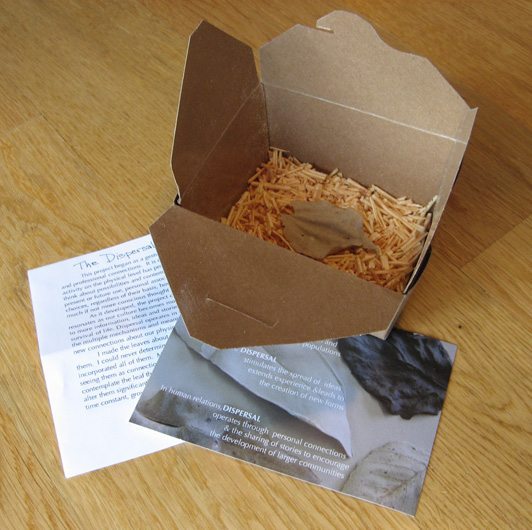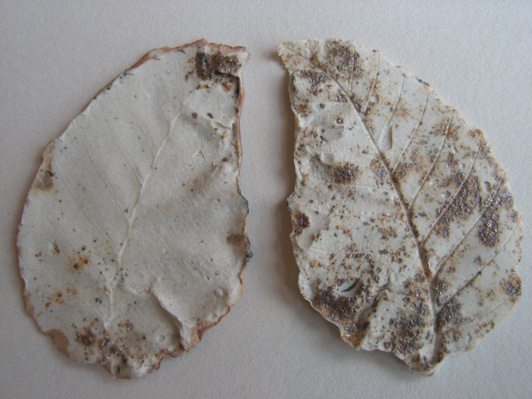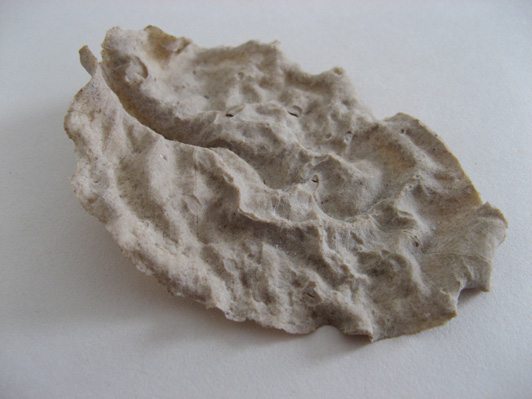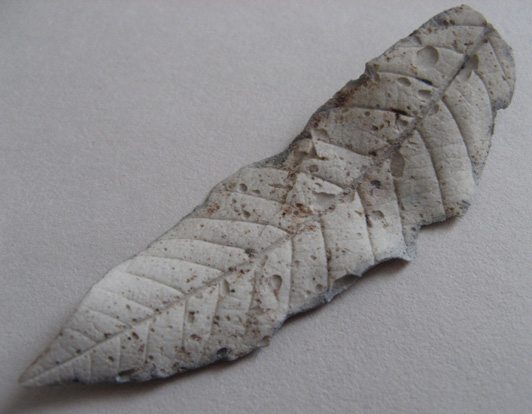Location: Oregon, Canada & France
INTRODUCTION
THE DISPERSAL PROJECT USES THE CONCEPTUAL model of dispersal in botany to examine aspects of contemporary art and culture. Its essential character is focused on connections between science, art practices and social relations. At the core of the piece is the distribution and dispersal of 200+ porcelain leaves.

DISPERSAL PROJECT RECEPTION- MARY & ANDREW CHOOSING, Amanda Schroer, Ash Street Project Gallery, Portland Oregon, 2010.
An event in Portland, Oregon, in March of 2010 to which more than 100 local people were invited marked the beginning of the Dispersal Project. The group included people from all aspects of my current life – neighbors who shared a local dog park, colleagues from my years of teaching, former students, new and old friends, my chiropractor and yoga associates and people whom I had encountered in my art practice in Portland. As the artist, I personally invited each person who attended the event to choose a leaf from the 200 + arrayed on a table in the space. Take-out boxes with a bed of sawdust were provided for people to carry home their leaves accompanied by statements about the project and the process. Enlarged images of some of the leaves lined the walls of the space during the event. The next week, I delivered leaves to people in Portland who were unable to attend, sometimes encountering individuals but often simply leaving a take-out box on the doorstep.

In the following months I traveled from Portland to the San Francisco Bay area, stopping at several places along the way, meeting old friends and inviting them to choose a leaf. These included people with whom I had shared studio space, several people from a communal house we shared in the late 1970's, a former employer, old boyfriends and roommates, former collaborative partners in art projects, fellow students in graduate school, former neighbors, old camping companions and a number of people with whom I had maintained consistent contact since moving from the Bay area in 1989. Over the rest of the year I worked to find people from high school, and college and sent leaves via post to relatives and others throughout the United States, Canada and France. Finally, in January of 2011 my husband and I delivered the final leaf to the grave of the woman who introduced us. I. A PREMISE DISPERSAL PROJECT OPENING - LUCY's CHOICE, Amanda Schroer, Ash Street Project Gallery, Portland, Oregon, 2010
THE INVITATION FOR THE INITIAL EVENT LAID out the premise of the project, and pointed the way to a fusion of ideas and activities in art, botany, and social relations.
In botany Dispersal facilitates plant reproduction & can lead to genetic variation as well as the growth and spread of populations. In art Dispersal stimulates the spread of ideas, extends experience & leads to the creation of new forms.
In human relations Dispersal operates through personal connections & the sharing of stories to encourage the development of larger communities.
The need to disperse belongings from my home and studio came from the process of retiring and moving. It grew into an extended meditation on relative value and choice, and served as a way to contemplate my past in the service of clarifying my goals for the future. While packing and sorting I discovered a box of porcelain leaves I had created at least twenty years earlier that were stowed away and forgotten. Originally I had made them for an installation that was never satisfactorily completed. Finding them when I did, and from the changed perspective of twenty more years of experience in life and art, they became the catalyst for this project.
Through volunteer work at a seed bank for rare and endangered native plants, I had learned about the dispersal of seed and conditions required for germination. I saw correlations with the dispersal of stories in human cultures and the dispersal of experiences through art. Through this project I could re-examine some of my personal stories. I saw the dispersal of these leaves as marking points in my life experience, creating a pattern reflecting activities, interests and connections. A pattern which might become evident through interactions with the participants in the project. After years of teaching art, retirement provided an opportunity to re-evaluate my personal art practice- placing emphasis on the movement of the leaves into the world rather than the leaves themselves. At the same time the leaves carry messages on our relationship to the natural world. Each leaf would make its way to a new place, initially determined by me but then subject to forces beyond my control.
Wanting to know some of what would happen to the leaves led to the development of a blog. In addition, dispersing the leaves felt incomplete without a way for people to respond either to the personal interaction of the event in Portland and my visits on the west coast or to the sudden and unexpected appearance of the leaf. Given the geographical extent of the project, the Internet became an integral part of the project through the development of a blog (elizabethstanek.wordpress.com). Here people could find out more about the form and progress of the project through my multiple postings. Here also, people could leave a remark or respond to the experience and find out how others were reacting.
II. BOTANY

THE LEAVES IN THE DISPERSAL PROJECT function as a gesture of acknowledgment and connection, and as a call to pay attention to the natural world they reference. Plants play a crucial role in our life on this planet. The carbon and oxygen exchange provided by photosynthesis is an important factor in the makeup of our atmosphere, and our food staples have long been based on plants. The environment is, among other things, an intricately balanced and constantly shifting set of relationships between plants, animals, insects and weather conditions. Radically changing any part of it will have consequences on all the others.In the year 2000, 80% of the population in the USA lived in cities. As this percentage increases, it is likely that ever more people will find the feel of concrete and asphalt under their feet much more familiar than the feel of the earth. If we lose that sensuous connection to the natural world what will remind us of how important its healthy balance is for our lives, and how we each need to participate in maintaining that balance. The leaves are intended to serve as a sensuous and thought-provoking reminder of how inseparable we are from nature no matter how disconnected our culture may become. Each leaf could be seen as a 'seed' spreading awareness into the daily lives of the people who received them or learned about the project. III. ART
IN THE DISPERSAL PROJECT, PORCELAIN LEAVES replace seeds. Their potential for growth lies in the metaphors and associations they might have for the people who received them. Many people responded to their past or present experience with the artist who distributed them by relating personal stories. Others responded to the physical reality of the leaf – its delicacy, beauty, and exceptional representation of reality. Some people received the leaf at a time in their lives that gave its uninvited appearance special meaning. One recipient commented, ‘Your lovely leaf is a very positive transitional sign as I leave my village and home of 33 years for a new life .’ Often people responded to the symbolism of leaves as in this remark from another friend in changing circumstances, ‘ your leaf will come with me to a new place; it will be a symbol of the necessary scattering of the accumulations of a lifetime in order to begin again.’ A story emerged about phylomancy, a practice in which listening to the rustling of leaves was believed to reveal the future. A few leaves were broken in the process of delivery and responses to that fact were strong, ranging from slight paranoia to a contemplation of its significance.
‘Our leaf did arrive in pieces, despite the careful packaging. But as I read your statement and looked at the fragile little broken thing, it occurred to me how very apt it was as a metaphor for the fragile network we built during your brief time in West Michigan centered on the Urban Institute for Contemporary Art.’
The leaves are metaphorical on many levels. Leaves of deciduous plants grow, mature, change color and die each year – a fragile and ephemeral version of the cycle of life. ‘Turning over a new leaf’ is another and slightly different indication of change. The leaves in this project, created in a manner much like fossils and preserved in the form of high-fired porcelain clay, were packed away in a box of sawdust for 20+ years and then rediscovered to engender this project. These leaves had laid dormant for years and a convergence of factors, physical, temporal and conceptual, lead to their resurgence and redefinition in this project.
As well as functioning metaphorically, the leaves also acted purely as markers in the larger pattern of relationships that this project described. As in some contemporary art practice, the event and consequent experience of each participant is as important as the physical objects involved which in many instances are not even necessarily aesthetic. In the Dispersal Project the leaves have aesthetic value but are purposely placed outside the normal venues of sales or exhibitions in galleries or museums, using an alternative system of distribution that reinforces their intent.
IV. SOCIAL RELATIONS
BEFORE THE MECHANISMS OF DISPERSAL COULD be considered, there were decisions to make regarding who would receive leaves. These were personal decisions based on a history that evolved from multiple changes in my life. Such events often require a significant and focused response to assimilate and in this instance, art served as the medium through which responses to these changes could be considered.
Formulating a list of whom to include in this project became, in addition, an opportunity to meditate on the varying nature of human relations. Some connections are physically immediate and exist due to proximity in time and space, while other connections are unrelated to physical distance. Contemporary social practices increasingly make use of the Internet, in which relations are often almost entirely separate from physical reality. Often connections are the result of shared interest, or shared experience and common history. Many connections are founded on a set of imperatives as opposed to individual choice, such as family and work relationships. Despite their character these relationships can vary in nature from casual to intense and from distant to very personal. Each of these kinds of relationships was included in this project in acknowledgment of the variety and impermanence that occurs over the course of a life. Each kind of relationship required different mechanisms for dispersal and received varying responses.
Responses were generally a function of time and space, with more intense and then more contemporary connections most likely to respond. In many instances there was no response, prompting thoughts about the multiple and exacting conditions that are required for seed germination. From the 200 leaves that went out there have been about 60 responses ranging from phone calls and cards to emails and blog comments. Universally respondents were delighted to receive the leaf and to re-establish or reinforce a connection. A number of recipients were puzzled by how this leaf might function for each of them.
‘ A lovely leaf appeared at my door – it has not told me what it wants to do or be or go yet – but I am patient.”
The largest number of responses refer to life changes, personal connections to the meaning of the leaf, and reflections on the act of dispersal.
One former student shared these thoughts:
‘Dispersal seems a fitting act for you, given your focus on nature and its struggle for renewal. It’s an attempt, like much artwork, I think, to counter the impermanence of things .teaching too, was an act of dispersal .I like the fact that you’ve circled back to the past, revaluing and reinventing your clay leaves.’
What became clear as leaves were dispersed was the number of people who were connected to each other in ways that were only peripherally related to their connection with the artist. This changed the vision of dispersal as rays from a central core into something more closely resembling a web. This realization prompted the development of the blog as a logical final step for the project. It could be a place where the web-like structure might become evident as people related to the leaf, reflected on the experience of receiving it and thought about the overall form and content of the project.
V. DISPERSAL
IN BOTANY SEED DISPERSAL MECHANISMS are of utmost importance because plants are not mobile. Mechanisms such as gravity, wind, water, fire, explosive propulsion and animal/plant interactions allow plants to move their seeds to locations that might provide the conditions for growth. Seeds can be dispersed either individually or collectively and are also dispersed in time as well as space.
In this project the mechanisms for dispersal were initially grounded in physical reality and dealt with a variety of ‘populations” within the Portland metropolitan area. They included an inaugural event and a series of deliveries within the Portland area. The event was a direct physical and personal connection, whereas in the deliveries the degree of direct connection was a function of chance. A road trip on the west coast retained the original direct physical and personal connection over greater time and distance. As relationships became more physically and temporally distant it became necessary to rely on the Internet as a way to find people and reestablish a connection. Not knowing occupations, locations and even current last names sometimes meant connections were not made at all.
Although the mechanisms of seed dispersal are tailored to the needs of each individual species, once seeds have been dispersed, the potential for growth is subject to a complex array of factors. Weather conditions, soil conditions, insect, animal, and human activity all impact seeds. The percentage that grows is often a small portion of the total released, and even those may take years to germinate. In the Dispersal Project, similar results in terms of blog responses reflect the complex nature of recipient’s lives, as well as the time pressures and priorities of contemporary existence.
VI. PROCESS
THIS POEM DEVELOPED FROM AN EFFORT TO describe how the leaves were created. A copy was included in each box containing a leaf that was carried away or sent off.
Dispersal
Collect a multitude of leaves
Dip each one in porcelain slip
The slip, shrinking as it dries, may separate from the leaf creating two delicate and detailed impressions
Often the impressions are indistinct, incomplete, disintegrate upon touch or do not separate
Persist
Fire these pieces to 2300 degrees Fahrenheit
Survey the varied results
Note their character: glass-like, partially translucent, potentially more enduring, but still
fragile, ephemeral
Appreciate each one
END NOTES
All photos taken by Elizabeth Stanek 2010.
Please view the blog and comment at: elizabethstanek.wordpress.com




